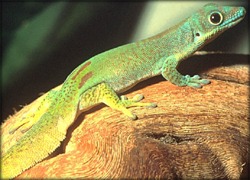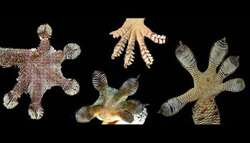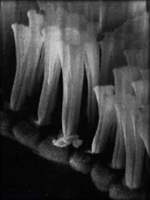 Scientists May Have Unlocked Secret of Sticking Power of Lizard's Feet
Scientists May Have Unlocked Secret of Sticking Power of Lizard's Feet
NEW YORK, June 8, 2000—They scuttle up vertical walls and can cling to a ceiling with a single toe.
 |
| Geckos are expert grippers and are capable of gripping up to 90 pounds in weight. (ArtToday) |
The sticking power of geckos has long befuddled scientists — dating as far back as 2,300 years ago when the Greek philosopher Aristotle first pondered how the mostly nocturnal lizards managed their trick.
Now a team of mechanical engineers and biologists have zeroed in on geckos and found their gripping power is even stronger than expected. They determined a single gecko about two inches in length is capable of holding onto about 90 pounds — about the weight of two small children.
And, surprisingly, the force that geckos use to maintain such gripping power appears to be made up of one of the weakest bonds in nature.
Understanding how the gecko’s toes stick isn’t just interesting for science, it could also lead to some useful innovations.
“There are countless possibilities,” says Kellar Autumn, a biologist at Lewis and Clark College in Oregon and lead author of the latest gecko study, published in this week’s journal Nature. “You could manufacture toys that crawl up walls. The adhesive could be used in nanosurgery or you can even imagine astronauts using gecko tape to stick things to satellites.”
 |
| The toes of geckos are lined with leaf-like flaps called lamellae. (Kellar Autumn) |
Examine a gecko’s toe closely and you’ll see several flaps of skin known as lamellae. Put those flaps under a microscope and millions of tiny hairs called setae (pronounced “see-tee”) are visible at the flaps’ fringes. Electron microscopy further reveals that, sprouting from the tips of each of these tiny hairs are thousands of tiny, slightly curved pads called spatulae. One gecko hosts billions of spatulae at the tips of its toes.
Why such intricacy? Autumn believes it’s designed to ensure maximum contact between the gecko’s toe and the surface it’s crawling on. The more surfaces there are, the better the chance that some of them will make close contact with a surface. And close contact is important since Autumn and his colleagues suspect that the forces that make gecko’s feet cling operate at a molecular level.
Van der Waals forces, named after a Dutch physicist of the late 1800s, are extremely weak attracting forces that exist between molecules. Molecules are made up of atoms, which are composed of neutrally charged neutrons, positively charged protons and negatively charged electrons. As clouds of electrons zip around the exterior of the atoms, they cause the charge around the atoms to fluctuate.
“It fluctuates very rapidly,” explains Autumn. “It’s throwing a positive charge here, a negative charge there.”
When the atoms of one molecule are placed very closely to the atoms of another molecule, the fluctuation in charge attracts the nearby atoms. This happens because fleeting negative charges at one end of an atom attract fleeting positive charges from nearby atoms — and vice versa. Because the charges are constantly shifting, the attraction is very weak. But the cumulative effect of a slight attraction between molecules in the gecko’s billions of spatulae and the surface add up.
“Our measurements showed a single hair-like seta could lift an ant,” says Robert Full, a co-author of the study and a professor of integrative biology at the University of California at Berkeley. “And just think, the gecko has 2 million setae.”
Once Autumn and his crew realized the strength of these bonds, they began to wonder how a gecko manages to un-stick its feet so effortlessly. To answer that question, they videotaped a gecko running on a mini treadmill and then slowed the tape way down.
 |
| At the tips of the lamellae are thousands of hair-like setae. One seta can lift an ant. (Kellar Autumn) |
Close examination showed that by uncurling its toe and then pulling slightly downward, the gecko achieves 600 times greater sticking power than friction alone could provide. Then, by uncurling its toes at a 30-degree angle, the gecko releases the bonds easily. Just like a piece of tape is more easily removed by peeling, the gecko unpeels its toes and releases its bonds one by one.
IS Robotics Inc. has already taken this information and fashioned wall-crawling robots that curl and uncurl their “toes” as they scuttle.
“Imagine tossing a swarm of these high-speed gecko robots into a burning building,” says Full. “They could crawl over any surface and find people so firefighters wouldn’t have to risk their lives going into the fire.”
The current gecko robot models use a glue-like adhesive to achieve their stick. But glue can be problematic since it doesn’t work as well when it’s dirty and it can eventually wear out. Autumn and Full are eager to replicate the gecko’s adhesive mechanism since it seems to be virtually problem-free.
The gecko’s adhesive never leaves residue, never gets dirty and never wears out. That means the animal isn’t emitting a sticky substance from its feet in order to stick. It also works in a vacuum, which rules out the possibility that the adhesion relies on suction, because suction uses trapped air to operate. It works underwater, which means it doesn’t rely on static cling. Finally, the sticking mechanism seems to work on any surface — including the perfectly smooth surface of a microcrystal — which suggests it isn’t using any interlocking system to attach.
Ruling out those possibilities is what led Autumn and Full to believe that Van Der Waals forces are the main source of grip. Now the real test will be in trying to replicate it.
As Full says, “Animals like the gecko are like libraries of information. They have some of the best secrets out there.”
 |

